Cleaning the chimney pipe is one of the key points in caring for a heating device, contributing to its long-term efficient work to the delight of the owner and his family.
Related articles:

The efficiency of a wood-burning stove or fireplace has a certain dependence on the cleanliness, serviceability and general condition of the chimney. Every owner must know how to clean a chimney, even if he prefers to use the services of third-party specialists and organizations.
According to experts, if the chimney is properly arranged and equipped, it will be able to remain clean for a long time if the heating device is used carefully.
For example, if you use dry wood that does not contain a large amount of resin to fire the fireplace, clean the ash from the ash pit, and do not burn household waste in the fireplace, then care will only consist of clearing the soot from the cleaning holes located in the room.
However, even with this option, the general condition of the chimney must be monitored every 6 months to ensure that it remains good. After all, pipes and chimneys are cleaned not only from soot, but also from debris, cobwebs and other blockages that accidentally get there. As for the question of when and how to clean the chimney pipe, it must be decided upon the fact that it is partially clogged with soot, residues of firewood and other types of fuel, and all kinds of blockages.
Why clean the chimney?
To improve traction
Settling on the walls of the chimney, soot over time narrows the existing clearance and interferes with the free passage of smoke. In addition, a dense coating of soot does not allow the chimney walls to fully warm up, which can lead to a decrease in draft, a decrease in the efficiency of the fireplace, and smoke penetration into the room.
To ensure safety when using the fireplace
There is a risk of soot catching fire in the chimney due to the high temperature. This development of events is fraught with the onset of cracking of the walls of the chimney, which will gradually lead to its complete destruction. But that's not all. Sparks that fly out of the chimney can cause a fire, which is extremely serious. Poor traction performance can also have bad consequences. For example, they can lead to carbon monoxide poisoning.

Methods for cleaning a chimney
Traditional methods
Many owners are looking for ways to clean a chimney. folk remedies at home.
Cleaning a chimney pipe is quite unsafe (to carry out such cleaning you need to climb on the roof) and very dirty (cleaning the pipe from soot will definitely leave marks both on clothes and on the body).
Most popular way The solution to this problem is to sprinkle the firewood with rock salt while it is burning. This action is preventative and is used to reduce soot deposits.
To remove existing plaque on the walls of chimneys, you can use potato peelings. First, you need to heat the fireplace well, then pour large quantities of potato skins into the fire. You can also use potatoes cut into small pieces (you will need half a bucket or a bucket of potatoes). The steam that will be released as a result of this action will decompose the soot flying into the chimney. Large accumulations of soot will fall into the oven, which must be cleaned after the removal process is completed.
It should be noted that a product such as potato peelings is not a full-fledged chimney cleaner, but is one of the means that helps soften soot, causing it to lag behind the pipe walls. After the above procedure, it will be necessary to mechanically clean the pipe.
If the farm has aspen firewood, then the question of how to clean the chimney from soot using folk remedies will disappear by itself. You need to take several armfuls of such firewood and simply burn them. It is worth noting that this method is not absolutely safe. Cleaning the chimney from soot occurs due to a significant increase in temperature in the chimney pipe. Under such conditions, the soot ignites, causing flakes to fly out of the pipe. white, which cover the roof and surrounding area of the house. Before cleaning a chimney pipe in this way, you should make sure that it can withstand a similar temperature load and will not collapse. If there is a large amount of soot in the stove pipe, then clean it better way which will be more secure.
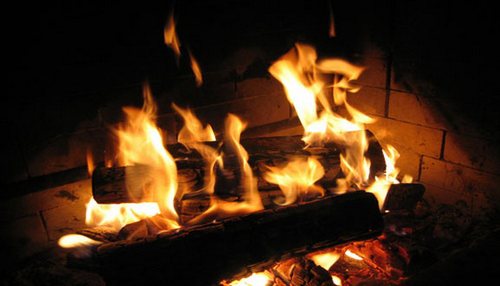
Mechanical pipe cleaning
Meeting a chimney sweep on the streets of the city is very rare, but this does not mean that the number of representatives of this profession has decreased significantly.
The profession of a chimney sweep is quite in demand these days. Not every owner has the tools necessary for cleaning a pipe, and even more so, not everyone agrees to do this difficult and unpleasant work on their own. And only a small percentage of owners of fireplaces, stoves, and boilers have theoretical knowledge of how to clean a chimney pipe.
The chimney sweep is a professional in his field. He will not only perform such work in an excellent manner, but will also additionally inspect the chimney, identifying possible damage and cracks in it. In addition, only a specialist will be able to adequately assess the level of functioning of the heating device and check the draft.

However, many owners of heating devices prefer to care for them themselves. It is extremely important to know how to clean a pipe from soot and various contaminants. After all, the operation of a fireplace should not be accompanied by constant anxiety and inconvenience.
What to consider when cleaning a chimney
It is important to close all cleaning holes in the room before climbing onto the roof. This is necessary to ensure that soot does not get inside the room (house, bathhouse, etc.). The fireplace/stove door and boiler outlet should also be closed or curtained with a damp cloth.

Cleaning the chimney pipe should only be done in dry weather with no wind. This condition must be observed to ensure your own safety. It is mandatory to use insurance when working on a roof.
If the fireplace or stove has not been used for a long time, you must ensure that there are no bird nests. If they are present, then they must be pulled out through the top of the pipe, and if this is not possible, then pushed down with a stick.
Major cleaning of the chimney is carried out only if the layer of soot on its walls is more than 2 mm. If the layer is thinner, it is recommended to use other cleaning methods described below.
Special attention should be paid to those devices and tools that will be necessary for cleaning the pipe.
The main tool of a chimney sweep is a metal brush, its diameter exceeding the diameter of the chimney pipe by approximately 20%. It is also possible to use a brush with stiff metal bristles designed for cleaning the chimney. It is advisable to use such a brush when working with structures that have a rectangular or square cross-section.
If during operation the brush is attached to a cable and lowers down on it, then the brush is attached to durable and flexible holders that are connected to each other as the brush is lowered down.
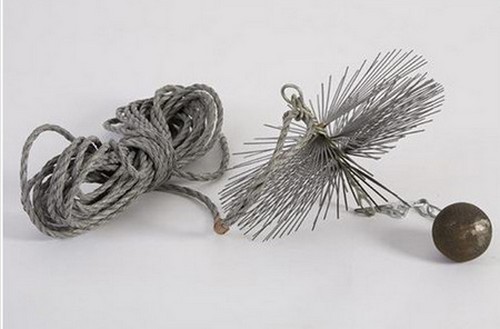
As an additional tool when cleaning pipes, a scraper and a heavy ball-shaped core are used.
If a dense layer of soot forms in the chimney pipe, it is initially necessary to clean it off with a scraper, and only then use a special brush or brush.
It is likely that during the cleaning process a blockage will be discovered in the chimney, making it difficult for the tool to further pass. Such an obstacle may be an accumulation of debris or a collapsed piece of brickwork. Such a blockage is removed by punching it with a heavy steel core attached to the cable with a carabiner. The core must be carefully thrown in the center of the chimney opening so as not to touch the walls.
Important clarification: previously, a core with a diameter of 85 mm was used as standard, but today circumstances have changed. Due to the fact that chimneys may have enough big square cross-section, it is recommended to use a core with a diameter that will cover more than 2/3 of the chimney cross-section.
Also, when cleaning a chimney, the core can be used not only as a means to remove chimney blockages, but also as a weight for a brush or brush. The core, ruff and cable can be connected using durable carabiners, which have the ability to change the design by removing an unnecessary section from it.
It is worth remembering that using sports weights and similar objects as a core is strictly not recommended. The fact is that they have a shifted center of gravity. They can get stuck in the chimney, turning over during the flight. And removing such items from the chimney channel is an additional expenditure of effort and time.
Vlad Zhitin, expert
It is advisable to clean open-type fireplaces with straight chimneys from below - from the firebox side. For this purpose, metal brushes are used on an extendable (composite) handle.

After cleaning the chimney, you need to carefully open all the cleaning holes in the house and remove the dirt that has accumulated in them using a dustpan and brush. You can also do this with a special spoon for removing soot. It is advisable to remove soot residues using a vacuum cleaner.
The final and finishing touch is cleaning the firebox itself.
Chimney cleaning using chemicals
Periodic maintenance is encouraged to prevent soot from settling on the chimney pipe. This prevention is carried out with the help of chemicals added to the firebox while the wood is burning there. The form of release of such products can be very different: briquettes, liquid, powder. The principle of their operation is quite simple. When burned, these substances release gas (it is absolutely harmless to humans), which destroys the structure of blockages and deposits on the walls of the chimney pipe and causes them to fall down in crushed form.
Below is short description the most common chemicals for chimney cleaning.
Anti-carbon chemical composition (ACC). Available in powder form. The product must be burned together with the packaging, adding it to the firewood while it is burning. It can also be burned separately from firewood. PHC has a clearly defined usage rate - 150-200 g for every ton of fuel.
"Kominichek." This is a chemical product for cleaning chimney (stove, fireplace) pipes, developed by a Czech manufacturer. Form of sale - packages, each of which contains 5 sachets weighing 14 g. One such package is enough for prevention for three months. The product is most effective when cleaning small layers of soot (layer thickness should be no more than 2 mm). Removal of soot and soot occurs due to the conversion of soot into an instantly combustible oxide (catalytic reaction and its consequences).
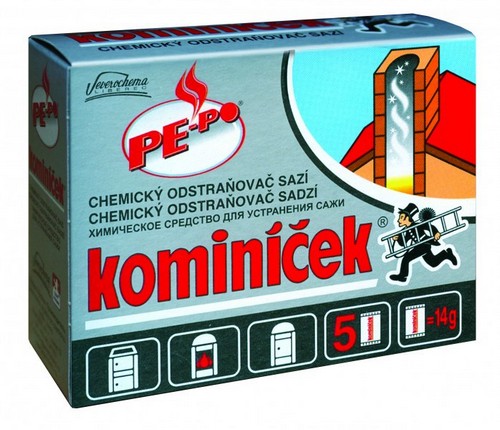
The method of application is quite simple. “Kominichek” (one bag) must be thrown onto burning coals or firewood and the door closed. High temperatures cause the granules to release a chemical that dissolves soot in the firebox and chimney.
Chimney Sweep log. The product is a small briquette or bar, which, when burned, releases substances that dry out deposits on the walls of the chimney pipe. As a result of this effect, deposits fall into the firebox.
Chimney Sweeper logs for cleaning chimney pipes is the most popular chemical product for cleaning chimney pipes. Its main purpose is to regularly clean smoke ducts for the purpose of prevention. The use of this product helps reduce the risk of creosote deposits and reduces the risk of soot ignition. Thanks to such effects, the service life of the chimney increases significantly.
The Chimney Sweep log can be used in any type of built-in heaters, stoves, boilers that operate using liquid and solid fuel. It is also possible to use it in fireplace inserts and stoves operating on coal and wood.
When using the fireplace up to two days a week, for prevention you will need to burn only one log every 6 months. If used daily, the number of logs will have to be doubled. If you are constantly using a wood-burning stove over a long period, it is recommended to burn one Chimney Sweeper log in it every two months.
In fireplaces and stoves with large dimensions, it is necessary to burn two logs in turn (before placing a new log, you need to wait until the previous one is completely burned).
This product demonstrates its greatest effectiveness when combating soot deposits in brick chimneys.
Before you start using the product, you should make sure that the chimney pipe is not clogged with various debris and foreign objects. It is best to burn the Chimney Sweeper log in this way: remove it from the packaging (leave the wrapper on) and place it on the coals remaining from the previous fire. You can set fire to a log or a wrapper. The essence will not change.
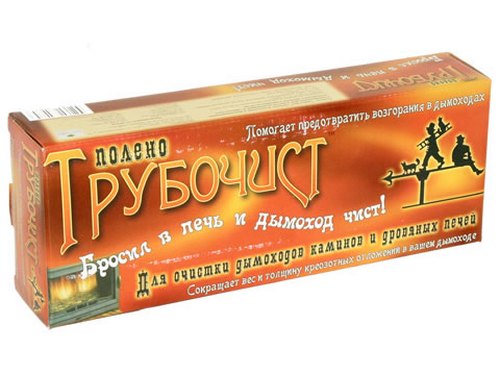
The active additives that are components of the log continue to act for one to two weeks after the log is burned. All this time, soot will continue to fall into the firebox without remaining on the walls of the chimney pipe. Two weeks after using the log, it is necessary to clean the fireplace elements and the chimney separately.
When using any chemical product intended for cleaning a chimney, you must strictly follow the instructions included with the product.
Cleaning quality control
Chemical methods of cleaning chimneys often do not inspire confidence among people. There is an understanding that the quality of such cleaning is noticeably inferior to the quality that a professional chimney sweep can provide. In addition, upon completion of his work, the specialist always carries out quality control of his work and general analysis chimney condition. For this, special tools are used, for example, mirrors.
Serious companies working in this area (various service centers etc.), for the purpose of quality control, special video cameras with a backlight function are used. With their help, you can fully evaluate the quality of work and eliminate shortcomings, if any.
There are certain rules for using a stove or fireplace that help extend their full service life.
- Do not use firewood obtained from coniferous trees as fuel. The reason for this is the high content of resin in them, deposits of which remain on the walls of the chimney.
- Do not burn a stove or fireplace with damp wood or firewood from recently fallen trees. High humidity contributes to increased deposits of soot and water vapor.
- You should not burn any kind of garbage. This is especially true for products made of plastic and other synthetic materials. Objects intended for this purpose must be used as fuel.
- Among all types of firewood the best option Dry hardwood firewood is used for the firebox. After heating, it is advisable to additionally burn a small amount of aspen wood. They help burn soot out of the chimney.
Now you know the main options for cleaning chimney pipes. It should be remembered that additional inspection is necessary during such work. And don’t forget about prevention.
How do you clean the chimney? Using the methods described above or using something special? Leave your answers in the comments!
Expertise - sewerage, water supply
Ask an expert
How to clean a chimney using folk remedies, cleaning chimneys from soot - print version
Clouds of steam rising above chimney, indicate that the house is warm and comfortable. But circumstances in which the smoke becomes black, draft significantly deteriorates, and combustion products spread throughout the room clearly indicate the need to clean the chimney system. It needs regular cleaning of soot, carbon deposits and checking the passage for debris that prevents smoke from escaping. Otherwise, the concentration of carbon dioxide in the room increases, which can lead not only to problems with the human respiratory system, but also to suffocation. This article will focus on devices for cleaning chimneys.
Frequency of chimney cleaning and methods for determining the degree of contamination
Regardless of the quality of installation of the combustion product removal system, cleaning procedures must be carried out regularly. But the question arises over what period of time the contamination of chimney systems occurs. If you adhere to all operating recommendations, you can clean the chimney once every 3 years.

- The cause of clogging of chimney ducts can be the use of damp logs, as well as the burning of coniferous trees. This is due to the fact that the oils released during the combustion of resinous trees contribute to the deposit of soot on the walls of the chimney. In addition, it is worth remembering the main rule for using heating systems - do not burn plastic waste. This gross violation affects not only the rapid contamination of the chimney, but also the penetration of substances hazardous to health into the room.
- A clear sign of a dirty chimney duct is a change in the color of the smoke. If the system operates correctly, its shade will be transparent or minimally darkened. As soon as the color turns black, this indicates that the chimney is clogged and the need to apply cleaning procedures.
- In addition, the color of the flame can serve as an indicator of contamination. Similar to the shade of litmus paper, instead of the expected light orange, it clearly indicates the need to clean the chimney.
The feasibility of cleaning the chimney from soot
Despite the quality of modern materials that are used for laying the chimney pipe, any system needs timely, and most importantly, thorough cleaning.
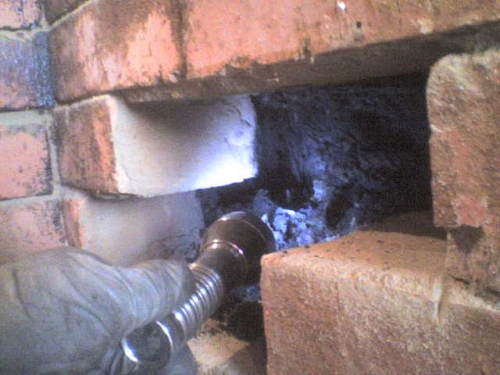
Causes
- The soot accumulated on the walls significantly reduces the clearance of the chimney and makes it difficult for smoke to escape.
- Plaque prevents complete warming up and reduces traction. As a result, smoke enters the room and the efficiency of the heating device decreases.
- Significant volumes of soot have a high flammability, which leads to the gradual destruction of the chimney masonry.
- Lack of traction can cause carbon monoxide poisoning.
Chemical cleaning of chimneys
To clean the chimney system, you can use a wide range of commercially available chemicals. This method is the easiest to use, but requires frequent repetition of the procedure. Chemicals are used precisely at the time of heating. During the combustion process, active substances are released that contribute to the structural destruction of soot deposits and its further detachment from the surface of the chimney pipe.
Effective smoke duct cleaning products
- PHC- potent Chemical substance against soot. The chimney cleaning powder is burned along with the fuel without being removed from the packaging. The amount of product can be determined according to the attached instructions. The most common proportion: 200 grams per ton of fuel.
- Kominichek- a chimney cleaner made in the Czech Republic. The package contains five sachets, each 14 grams. This amount must be applied within three months. Purpose of the product: removal of soot and soot. The layer thickness limit is no more than 2 mm. The substance, entering the chimney, triggers the reaction of converting plaque into oxide, which subsequently burns without forming a fire. The product is very easy to use: one sachet is immersed in the firebox along with the fuel.
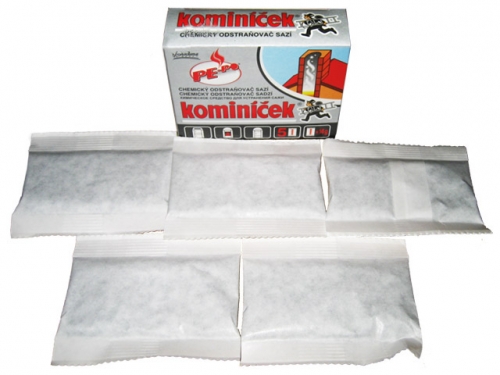
- Chimney cleaning log Available in the form of briquettes. Used during fuel combustion. Its effectiveness lies in the release of volatile substances that cause drying and separation of soot deposits. The product can also be used as a preventive measure. In this way, it is possible to extend the service life of chimney ducts by reducing the formation of creosote deposits and preventing soot from igniting. The product is most often used for smoke exhaust structures made of bricks.

DIY mechanical cleaning of chimneys
At one time, the profession of a chimney sweep was in great demand, because stove heating was in almost every home. In the century high technology and high-strength materials from which they are made modern systems chimneys most often require preventative maintenance rather than thorough cleaning. But, at the same time, having a certain skill, perform mechanical cleaning smoke exhaust systems can be installed independently.
To do this, you must adhere to the operating rules. Before starting cleaning, it is necessary to carry out preparatory work:
- it is necessary to close all smoke exhaust openings as tightly as possible to prevent soot from penetrating into the room;
- when cleaning the chimney, the vent and doors should be closed; it is recommended to cover the open fireplace opening with a damp and thick cloth;
- in case of prolonged inactivity of the heating device, it is worth checking the chimney for debris and bird nests - you can remove them manually or using a long stick;
Tip: the most favorable weather for the procedure will be dry and windless. When working, you must always use safety ropes.
A prerequisite for mechanical cleaning is the formation of a soot thickness of more than 2 mm. The following methods are used in the work:
- Metal brush for cleaning chimneys- is an effective item. It is worth considering that its diameter should be 1.5 times the size of the pipe. For square or rectangular chimneys, it is most appropriate to use a brush of a similar contour with stiff metal bristles. When cleaning with a brush, a long strong cable is used. When working with a brush, flexible holders are used, which are connected to each other as it moves along the chimney.
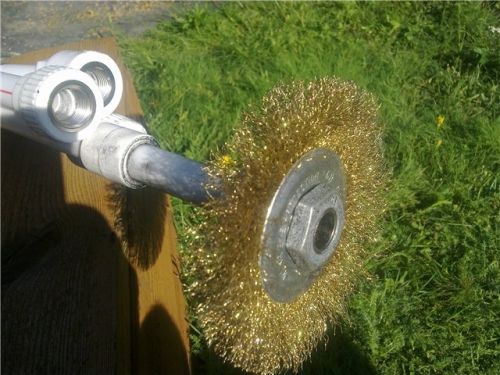
- Core- used to remove obstacles that have arisen in the chimney pipe when large debris or bricks have fallen from the masonry. In addition to the existence of a standard size of 80 mm, other options are used today that cover 2/3 of the pipe. If the soot deposit is quite dense, a special scraper is attached to it. The core is secured to a thick and durable cable using an iron carabiner. Then it must be lowered deep into the chimney at a minimum speed sufficient to remove congestion and soot, but without destroying the masonry. The core can be used as a weighting agent for brushes or brushes.
- Metal brushes with curved handle. Used to clean the chimney from the room side.
Advice: to clean the smoke exhaust system, it is strictly forbidden to use non-professional weighting agents, such as sports equipment. A shift in the center of gravity during operation can cause a situation in which an object becomes firmly stuck in the pipe. And then the only way to get it out is to completely dismantle the chimney.
Upon completion of the work, it is necessary to open all the dampers and doors of the heating device and carefully remove all debris and soot using a broom. Then the remaining dust should be removed using a vacuum cleaner.
Methods for cleaning a chimney using folk remedies
The choice of a folk remedy for cleaning a chimney is often associated with the availability of materials and products, high efficiency and environmental friendliness.
The most common means
- Salt. Sprinkling generous amounts of rock salt on the fuel is the most popular method. But, it should be considered only as a preventive measure for cleaning heating systems. Salt has the property of preventing the formation of soot.
- Potato peeling. To clean the chimney pipe in this way, you must perform the following steps step by step:
- the heating device must be thoroughly heated;
- potato peelings, weighing about five kilograms, must first be dried and then placed in the oven or fireplace. The starch released during combustion destroys soot and deposits. In a few days, the plaque will fall off the walls of the chimney. After that, using a brush with a curved handle, you need to clean the system.

- Burning aluminum cans. A rather unusual method of cleaning a chimney, but nevertheless with proven effectiveness. To remove contaminants, it is necessary to carry out the procedure of burning cans - once every ten heating processes. The procedure is carried out only for devices operating on the basis of solid fuel.
- Watering hose. To carry out the cleaning procedure using a hose, it is necessary to remove the glass located at the bottom of the chimney. Then, position the water pump as high as possible. For this purpose, a tight hose or a connection option with a strong and flexible wire is used. Strong water pressure washes away all plaque from the chimney walls.
- Aspen firewood. When burning firewood from this type of wood, the maximum combustion temperature is reached. When the flame hits the chimney pipe, soot and plaque on its walls are burned. The process is not as safe as it seems. Ignition of soot can lead to damage to the integrity of smoke exhaust ducts and a fire. This method should be used with caution and only for a durable chimney system.
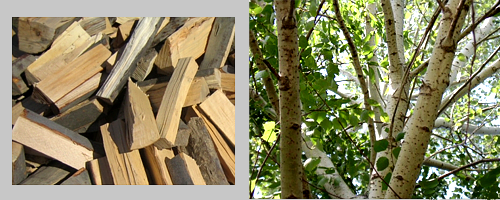
- How to control the quality of cleaning. After completing all work on cleaning the smoke exhaust ducts, carried out independently, it is necessary to conduct a thorough examination for possible defects and places in need of repair. For this purpose, special magnifying mirrors can be used. But more in a modern way Compact video cameras with backlight are considered. True, such equipment is not cheap, but if a stove or fireplace is used on an ongoing basis, it makes sense to purchase it.
Preventing chimney clogging
To maintain the constant operability of chimney systems, it is necessary to carry out preventive measures to prevent the formation of soot deposits:
- Do not use coniferous wood for heating a stove or fireplace. Due to the large amount of tar compounds included in the composition, such firewood causes significant formation of soot and tar deposits on the brickwork of the chimney pipe.
- It is not recommended to use unseasoned wood or freshly cut trees. Increased moisture content in fuel promotes the formation of soot and water vapor. Which over time leads to the destruction of the chimney masonry.
- To avoid the formation of carbon deposits, you should absolutely not burn the following in the heating system: household waste, plastic and bags. In addition, toxic fumes from burning synthetic materials enter the room and poison the air.
- If possible, complete the heating process by adding several aspen firewood, as a preventive measure and to eliminate a small soot deposit on the walls of the chimney.

Chimney cleaning video
Periodic cleaning of the chimney during active operation of heating systems is a necessary procedure that extends the life of its use. Having information on cleaning and prevention methods, you can easily independently eliminate defects in the chimney masonry design, remove carbon deposits and soot, as well as unwanted debris. Remembering to take precautions when working with heating appliances.
Private house, fireplace, nature. This is probably the dream of most people, because it’s so great to sit in front of the fireplace with aromatic coffee or with your favorite book and surrender to the pleasure of a relaxing holiday. But no matter how wonderful it all sounds, the fireplace needs to be cleaned, and not only the fireplace, but also the chimney. Therefore, those who are the proud owner of a fireplace or stove should know how to clean the chimney in the stove of a private home in order to really enjoy their presence, and not expose themselves to the risk of gas poisoning. In this article we will teach you this, and also tell you about the reasons for a clogged chimney and other useful points.
Cleaning chimney pipes using traditional methods
Many stove makers use traditional cleaning methods, because the work itself of cleaning chimney pipes is dangerous. And you can clean the chimney in the stove of a private house in more harmless ways.
Rock salt
The most common method is to sprinkle rock salt on the wood during the burning process. You should know that this salt is most often used to prevent soot from appearing.
Potato peelings
Thoroughly heat your fireplace or stove, then put a large number of potato skins into the fire. The steam released will decompose the soot that has entered the chimney.
With all this, heavy pieces will fall to the bottom of the stove, which will need to be cleaned.
Important! Cleaning with potato peelings is not complete. They are only suitable as a tool that helps soften the soot and makes it easily come off the surface of the pipes.
After carrying out such preparatory work, it is necessary to clean the chimney in the stove using the usual manual method.
Aspen firewood
If you have aspen firewood, cleaning the stove and chimney can be quite simple. To do this, simply burn a small amount of armfuls of aspen firewood.
This method is somewhat unsafe, because cleaning is carried out by obtaining a very high temperature in the chimney structure itself, during which the soot begins to burn.
Important! If you plan to use this method, make sure that your chimney can withstand heavy loads and not be damaged after this procedure.
If there is a large layer of soot deposits in the pipe, we recommend not to take risks, but to use a safer and simpler method.
How can you clean a chimney using manual methods?
A chimney sweep who has extensive experience will clean the chimney pipe efficiently and quickly, and can also inspect the entire structure for the formation of any cracks, assess the working condition of the heating device, and the presence of draft.
If you decide to clean the chimney in the stove of a private house yourself, the correct sequence of work will be as follows:
- At the very beginning you must close all the holes. This must be done so that soot cannot fly into the room.
- Close the oven door as well. If the stove is open, we recommend hanging a wet cloth on the firebox.
- Clean the chimney only in dry weather. There should be no wind during cleaning. Be sure to use insurance.
- If your stove has not been in use for a long time, the first thing to do is make sure that there are no bird nests inside the structure. If you are unable to remove the nest or debris from the upper part of the structure, push it down using available means.
- Clean the chimney when the layer of soot on the surface of its walls is more than 2 mm. If the soot layer is smaller, you may not need to perform a complete cleaning. In this case, use alternative methods.
- If the soot layer is quite dense, first scrape it off. Only after this use a brush or ruff.
We remove blockages with the core
During the cleaning process, blockages may be found inside the chimney structure, which will prevent the tools from moving further. The blockage can be in the form of any debris or a brick that has fallen out of the masonry. In any situation, it is necessary to clean the chimney in the stove of a private house.
Important! If the chimney has been in use for a long time, then the likelihood of finding such debris in it is quite high.
The blockage must be broken through with a heavy steel cannon attached to a rope with a carabiner. Throw it into the center of the opening of your chimney structure, while trying not to touch the inner surface of the pipe wall.
Metal brush with weight
The core can be used not only to remove blockages, but also as weighting agents for a brush or brush. A brush with a load is lowered into the chimney pipe, while it not only removes soot, but also eliminates foreign objects. This way you will be able to properly clean the chimney in the stove of a private house.
Connect the cable, brush, and core to each other using carabiners, which allow you to change the structure by removing any section from it.
Important! Select a core size that will cover at least 2/3 of the chimney diameter.
Instead of the core, you cannot use sports weights or any other objects that have a large weight and a displaced center of gravity. These items can tip over and then become stuck in the chimney duct for a long time.
Important! If the core fails to remove jammed objects, dismantle the entire chimney structure.
Wire brush
Open stoves, which have a direct chimney, can be cleaned not from the roof itself, but from the side of the stove. To do this, you will be forced to use metal brushes on an elongated handle.
After you have finished cleaning the stove, open all openings as carefully as possible to clean and remove any existing dirt using a brush and dustpan or a spoon designed for soot.
Important! Using a home vacuum cleaner, you can eliminate all remaining soot. Finally, open and clean the fireplace insert, and don’t forget about the vent.
The smoke damper also needs cleaning. To do this job, use a vacuum cleaner or fireplace brush.
How to clean a chimney using chemicals?
The most effective and common chemicals that will help you clean the chimney in a private home stove are the following.
Soot composition
This powder is designed to clean the entire chimney structure. Burn it along with the fuel without spilling it out of the package. The consumption of this product is standardized: 100-160 g of powder is needed for 1 ton of fuel.
Kominichek
One package contains 5 packets of 15 g each. This amount is enough for approximately 3 months of preventive procedures.
The product allows you to clean the chimney in the stove of a private house from soot and soot. With its help, a reaction will be caused, during which the soot will turn into a kind of oxide - it burns even at low temperatures.
Used this remedy quite easy: place 1 sachet in the firebox directly on the burning fuel, then close the door. Due to the effect of high temperature, the granules will release elements that are capable of dissolving soot on the surface of the walls of the firebox, as well as inside the chimney structure.
Important! Before purchasing any chemical, carefully read the operating instructions and the manufacturer's recommendations regarding the use of products in heating devices various types. Not all products are global; some can only be used in closed fireboxes or wood-burning stoves.
How do you know when it's time to clean your oven?
In order to understand whether it is time to clean the chimney in the stove of a private house:
- Pay your attention to the smoke, because a change in its color indicates that it is time to clean the stove.
- Check the draft - it becomes very bad, and the stove burns poorly. This means that the chimney pipe is already clogged.
Important! If the stove is used correctly, the color of the smoke should be transparent or white. But if the chimney is dirty, then the color starts to be black and gets darker and darker. This means that soot has settled across the entire surface of the chimney and prevents it from functioning as it should.
Reasons for soot accumulation
There are a fairly large number of reasons why soot and other combustion waste accumulate on the surface of the walls of the smoke exhaust structure:
- Violation of the technology for laying structural components of a stove, fireplace or chimney.
- Improper operation of these structures. Improper operation means the burning of raw fuel in furnaces, which contains a large amount of resins, as well as other waste from the chemical industry, for example: polyethylene, plastic and other similar household waste.
- Poor quality material that was used during installation of the chimney structure.
- Getting inside the chimney structure of unnecessary objects in the form of small birds, insects, debris that is blown by the wind.
- Lack of protective umbrella on the top of the pipe.
- When laying a chimney pipe, the internal clearance parameters must be observed. If they are less than the standard ones, as a result, over time they will become overgrown with combustion waste in the form of soot. And this, accordingly, reduces the craving - lighting a stove or fireplace becomes quite problematic.
- Residues in the middle of the pipe of solution build-up also accelerate clogging of the chimney pipe.
Now you know everything about caring for chimney structures, and it won’t be too difficult for you to keep them clean and tidy.
Tips for the home handyman
0
Cleaning the chimney of soot is the main point of preparing a heating device for winter. This allows you to increase the efficiency and duration of its operation, which depends precisely on the serviceability and cleanliness of the chimneys. Every owner of a private building should know how to clean chimneys from soot using folk remedies, regardless of whether he does the work himself or uses the services of specialists.
Why do you need to clean chimneys?
Increased traction
Accumulating in the chimney, soot contributes to the narrowing of the lumen, interfering with the free exit of smoke. In addition, the accumulation of soot prevents complete heating of surfaces, leading to a decrease in draft and efficiency of the heating device, as well as smoke entering the room.
Security
High temperatures emanating from the stove can cause soot to ignite, which causes cracking of the chimney, followed by complete destruction. In addition, flying sparks can cause a fire, and poor draft can cause carbon monoxide poisoning.
Methods for cleaning chimneys

Folk remedies
Many people are interested in how to clean a chimney from soot using folk remedies. The job of cleaning a pipe is quite dirty and somewhat dangerous. Therefore, it is worth paying attention to easier ways to get rid of soot. One of the popular solutions to this issue is to sprinkle rock salt on burning firewood. Of course, it will not be possible to completely clean the chimney, but it is quite possible to reduce the amount of soot.
To remove plaque formed in the chimney, you can use potato peelings. A large amount of potato peels is poured into a well-heated fireplace. You can also use finely chopped potatoes, which will require about ½ a bucket. The steam released when potatoes burn helps decompose the soot that comes out. A huge amount of plaque will fall into the oven. It will need to be cleaned once the cleaning process is complete.
It is worth noting that this option is not capable of completely freeing the chimney from soot; it only contributes to the softening and peeling of plaque. After this is done, you will still need to clean the pipe mechanically.
If you have aspen firewood, the problem of how to clean a chimney is easily solved. To do this, it is enough to burn 2-3 armfuls of logs in the stove. However, this method is not safe. Removal of plaque occurs due to an increase in the temperature inside the chimney, which promotes the ignition of soot, which flies out in white flakes. Covering the local area and roof surface, it can cause a fire.
Mechanical method of cleaning a chimney
Despite the fact that today it is almost impossible to meet a chimney sweep, this profession still remains quite in demand. After all, not every owner knows how to properly clean a pipe, and what is required for this work. A professional chimney sweep will do an excellent job. In addition, he will inspect the smoke ducts for possible cracks or beginning damage. Only a specialist will be able to qualitatively check the traction, correctly assessing the degree of functionality of the device. But, if you want to take care of the fireplace yourself, you should know how to clean the chimney from harmful deposits.
First of all, it is necessary to strictly observe safety:
- Cleaning chimneys from soot in rain or strong wind is strictly prohibited;
- you should take care of insurance - if there is no special safety system, a strong rope is tied around the belt;
- When planning to clean chimneys, it is not recommended to take medications that slow down the reaction.
Compliance with these rules will allow you to avoid possible risks during work.
What to consider
Before climbing onto the roof, close the cleaning holes to prevent soot from entering the room. The firebox door is also closed or covered with a wet rag. If the fireplace has not been used for a long time, you should make sure that there are no bird nests inside. If there are any, they are taken out through the pipe or pushed down with a stick.
Particular attention should be paid to the devices necessary for the procedure. From time immemorial, the main tool was considered to be a metal brush, the diameter of which is 20% larger than the outlet of the pipe. Also, for this procedure, you can use brushes with metal bristles. They are convenient to work with square or rectangular structures. The brushes are fixed on durable holders, the length of which increases as they are lowered.
To clean the chimney from soot, you can use a special scraper and a heavy spherical core.
When dense carbon deposits have formed in the pipe, it is removed first with a scraper and then with brushes and ruffs.
When cleaning smoke ducts, it is possible to discover a blockage that prevents further passage of tools. This could be fallen pieces of bricks or an accumulation of debris. You will have to pierce a kind of cork with a heavy cannonball tied to a cable, carefully throwing it inside, trying not to catch the walls.
Do not use sports weights! They have a shifted center of gravity, so they can get stuck inside the pipe, which will significantly complicate the process.
Open fireplaces equipped with a straight chimney are cleaned from below, using metal brushes with assembled (increasing) handles.
Having finished cleaning the chimney, open all existing cleaning holes, using a dustpan to clear out the accumulated dirt. Fireboxes are cleaned in the same way.
Removing soot using chemical means
Thinking about how to clean soot from chimneys folk ways, you should pay attention to the chemicals offered by the industry for such purposes. They come in powder form, liquid form and briquettes, and have a fairly simple effect. The combustion of these products contributes to the release of gas that is harmless to people, destroying deposits and blockages inside the smoke ducts. In addition to cleaning, such products have a preventive effect, preventing the accumulation of soot in the future.
The anti-carbon chemical composition is in the form of a powder, which is placed directly on top of burning firewood in the package. The product has a clear usage rate of no more than 200 grams for 1 ton of fuel.

The chemical substance “Kominicek”, from Czech manufacturers, has a powdery structure. One package contains 5 individual sachets, each weighing 14 grams. The actions of the product are aimed at removing layers of soot, with a thickness not exceeding 2 mm, by converting it into a quickly combustible oxide. To carry out the procedure, one 14-gram sachet is thrown into a burning hearth. Due to the high temperature, substances are released from the drug granules that contribute to the complete dissolution of soot.
The special “Chimney Sweeper” log, when burned, is capable of releasing substances that dry out soot. It is used for preventive treatment of smoke ducts. The use of the substance prevents the formation of creosol deposits with soot combustion. It is perfect for all types of heating devices operating on both solid and other fuels. With regular use of the fireplace, it is enough to burn one Chimney Sweeper log for 3 months to prevent the formation of plaque in the chimney and moves.
For large heating appliances, you will need to burn two logs alternately. Greatest effect the product is effective in combating soot deposits in brick pipes. However, before you start cleaning, you should make sure there are no blockages or foreign objects. The effect of the additives contained in Chimney Sweep lasts up to two weeks, forcing soot to actively pour into the firebox from the chimneys. After a two-week period, mechanical cleaning of the heating device should be carried out.
We control the quality of cleaning
Quite often, people do not trust chemical methods of cleaning chimneys, believing that their quality is significantly inferior to the work of professional chimney sweeps. Moreover, when completing the work, the specialist must check the quality of its execution by analyzing the condition of the chimneys. At the same time, he uses special tools, thanks to which a full assessment of the quality of work is carried out and possible shortcomings are eliminated.
The operation of stoves, fireplaces or other heating devices requires certain rules to extend their service life.
- You should not burn the fireplace with coniferous wood, as it contains a huge amount of resins that can linger in the chimneys.
- You should not use damp or freshly cut firewood; their high humidity increases the deposition of water vapor, increasing the amount of soot.
- It is not permissible to use the stove to burn waste, in particular synthetic materials, as well as plastic products.
- Deciduous wood has always been considered the best firewood, especially aspen, which prevents soot from settling inside the smoke ducts.
Having learned how to clean soot from a chimney using folk remedies and other auxiliary substances, you don’t have to worry about the accumulation of plaque in the chimney. If it occurs, you will always be able to solve this problem yourself.
The profession of chimney sweeps is not the most popular; people have become accustomed to dealing with blockages and large amounts of soot on their own. In addition, the development of independence is facilitated by a huge number of available methods deliverance brick oven and chimneys from congestion. Besides special means, folk craftsmen invent their own rather extraordinary methods of combating soot, which is just what aluminum cans or potato peelings cost, but first things first.
Cleaning your chimney should be a regularly repeated task. Even the most innovative designs, consisting of expensive and cutting-edge modules, require careful maintenance. No matter how hard you try to reduce the amount of deposited soot, the appearance of soot cannot be avoided. If you heat the stove with wood of poor quality, then the deposit can be impressive and difficult to remove. The amazing properties of soot allow it to accumulate even on vertical, flat surfaces, hence the need to clean the internal walls of the chimney and stove. If it is not cleaned, it may result in a fire in the bathhouse or house.
Chimney sweeps are not in demand today, due to the fact that men do not disdain menial work and are able to clean everything themselves. However, it is also not worth talking about the disappearance of this profession completely. If the chimney has complex design, with a lot of bends, then you should still give preference to a professional.
There are two types of smoke: noble white and harmful black. Light is formed from water and logs, dark from soot and coal combustion products. White smoke is completely safe for the internal walls of the stove. From black you can notice the appearance of an unpleasant coating, it is especially noticeable on inside, since, unlike the upper glossy surface, the material inside the structure is slightly rough. As a result of the intensification of such a raid, the thrust becomes much less, and the amount of fuel burned decreases. You shouldn’t let the situation get worse, because it can lead to disastrous consequences.
Getting rid of soot is not difficult, because modern bathhouse lovers come to the aid of industrial chemicals and brushes specially created for this. You don't have to climb onto the roof to clean problem areas.
We use a special brush
As in previous times, specialized brushes remain unrivaled. Not a single chemical  the remedy cannot compare with it. The only condition for success is that you need to choose it correctly. The type of chimney plays an important role here. Each of them is suitable for different models, and there are a great many of them on the market.
the remedy cannot compare with it. The only condition for success is that you need to choose it correctly. The type of chimney plays an important role here. Each of them is suitable for different models, and there are a great many of them on the market.
The first thing you need to decide is the diameter of the brush. It is impossible to clean the chimney with a large brush; at the same time, cleaning a small one will increase the time it takes to get rid of soot. Thus, properly selected brushes will allow you to clean the oven evenly along its entire length.
When choosing a brush, you don’t need to give preference to the first one you come across. Examine it carefully, understand what it is made of. A stiff nylon brush is ideal for removing clogs. Despite all its rigidity, it is able to adapt to the pipe and reach the most inaccessible places. The lint does not damage the surface, but at the same time thoroughly removes dirt.
For chimney bends, use a special brush. It will help you reach curved structures. It is the turns that accumulate a huge amount of soot, and getting rid of it is much more difficult than it seems at first.
Cleaning should be done with the utmost care. The fewer deformations and scratches that appear during the procedure, the longer the stove will serve you. Scratches and chips are uneven surfaces, and large amounts of soot and soot accumulate on them. Therefore, a brush with a flexible handle is an ideal option. It is easier for her to reach the dirt and easier to control when cleaning it.
Traditional method: potato peelings
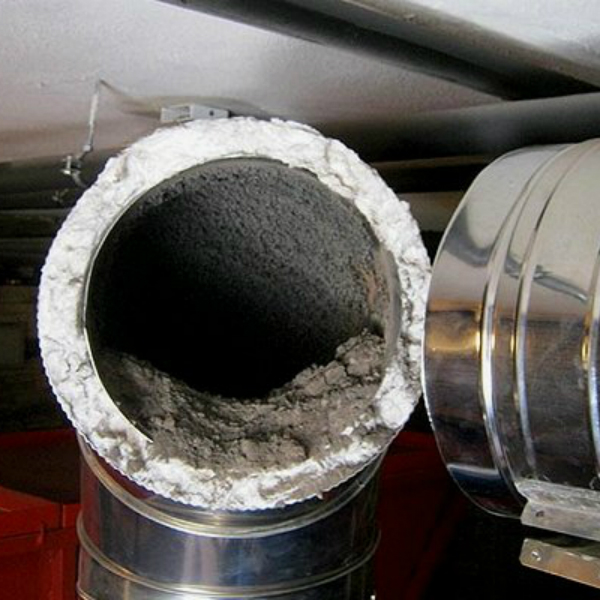 This method has been known for several centuries. In the absence of special tools, our ancestors came up with an amazing way to clean the stove.
This method has been known for several centuries. In the absence of special tools, our ancestors came up with an amazing way to clean the stove.
To carry out the procedure, you will need an impressive amount of potato peelings. Today this may be a problem, but rural residents in the old days did not have such a problem. But you managed to collect at least half a bucket of cleaning. We heat the oven well and pour all the available wealth into it. The quality of cleaning depends on the size of the pipe; the larger it is, the more potatoes need to be destroyed.
The effect of this method is explained by the effect of evaporated starch on soot. Mixing in the pipe, the soot begins to decompose and within a few days actively falls off the walls. But it doesn’t fall off completely, so after a few days we tie a ruff to the brick and send it down the chimney pipe. Noise and loss of soot residues are guaranteed.
The second folk method: we use aspen firewood
Firebox aspen firewood This is also not a new way. However, unlike the previous one, it cannot be called safe.
At the beginning, a firebox with aspen wood looks like any other. We lay the material and melt it well. This firewood burns well, so constant flooding leads to high temperatures. A great fire hazard lies in the fact that the oven doors must be open and firewood must be constantly thrown into them. Ultimately, this will cause the pipe to begin to hum, white soot flakes will fly out of it, and the soot inside will catch fire. When examining the pipe, you can see a flame from there.
Before carrying out such a dangerous maneuver, make sure that the design and material can withstand temperatures of 1000 degrees.
Method three: aluminum cans and hose
Burning aluminum cans is a relatively new method of cleaning soot from the stove. Once every five days, throw a couple of cans into hot coals. Please note that the cans must burn, so use hard coal. The cans will actually burn in it, producing very little soot, which means less clogging of the chimney.
Another existing, but very dubious method. You need to take the hose and insert it into the pipe from the firebox. The stiffer the hose, the better the result. After this, all the soot should fall down. You can further strengthen the hose by putting a brush or a cut plastic bottle on it.
Fourth innovative method: chemicals
Chemicals are not designed to completely remove soot from your oven. They refer to ![]() means of prevention. After using such products, the soot will fly off in places, but this will still lead to the need to buy and use a brush. Besides, chemical composition is not very attractive to consumers, since after use for a couple of days the stove retains a persistent synthetic odor, which worries consumers.
means of prevention. After using such products, the soot will fly off in places, but this will still lead to the need to buy and use a brush. Besides, chemical composition is not very attractive to consumers, since after use for a couple of days the stove retains a persistent synthetic odor, which worries consumers.
Having dealt with all the possible cleaning methods, we can conclude that the most effective and safest method is mechanical manipulation using a stiff brush with a flexible handle. Treat the stove with care, clean it of soot, and it will serve you for a long time.




